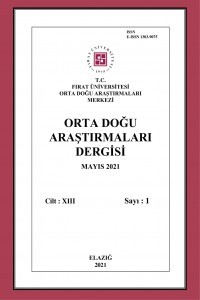Suriye’de Erken Dönem Osmanlı Timar Düzeni : Hama ve Humus Örneği
Bu çalışmada, Hama ve Humus örneğinde, Osmanlı hakimiyetinin ilk dönemlerinde Suriye’de uygulanan timar sistemi incelenmiştir. Osmanlı İmparatorluğu’nun Suriye bölgesinde yer alan çoğu ekilebilir toprakların mülkiyeti, İmparatorluğun Rumeli ve Anadolu bölgelerinde olduğu gibi, devlete aitti. Fakat, devlet buradaki topraklarını bizzat kendisi işletmiyor, belirli bir ücret karşılığında üzerinde oturan köylü halka kiraya veriyordu. Buradaki tarlaları ekip biçen çiftçi halk, hem toprağın kirası olarak elde ettiği ürünün belirli bir bölümünü öşür , hem de besledikleri hayvanlar için belirli bir miktar vergiyi devlete ödemek zorunda idiler. Devlet, bu vergi gelirlerini has, zeamet ve timar adları altında gelirlerine göre gruplara ayırdıktan sonra, bunları toplama işini, onların maaşlarına karşılık olmak üzere, orada görev yapan asker ve memurlarına verirdi. Böylece, imparatorluğun çoğu bölgelerinde uygulanan bu sistem Timar Sistemi sayesinde, bir taraftan toprak gelirlerinin önemli bir bölümü devlet veya onun temsilcileri vasıtasıyla toplanırken, diğer taraftan da burada görev yapan asker ve memurların maaşları devlete ilave bir yük getirmeden mahallinde ödeniyordu.
Ottoman’s Timâr System of the Early Period In Syria : Hama and Homs Models
The Ottoman’s Timar System of the Early Period in Syria with Hama and Homes Models is researched in this studies. The properity right of most of the fertilizable lands of the Syrian parts of the Ottoman Empires like the other part of the Empires such as Rumeli and Anatolian regions belogned to the state. However, the state was not running these lands for herself but had them rent with some amount of money for villagers. On one side the villagers planting these lands had to give some amount of their products named as öşür in Turkish to the state as the rent of the lands they hired. Moreover, they had to pay some amount of money for the animals they brought up. After dividing these incomes as “has”, “zeamet’’ and “timâr’’ groups depending on their revunue, the state had civil servants and military personel, who were working and living in the same area, collect the incomes and given them as respect to their salaries. Finally, because of this system the Ottoman timâr system which was applied almost most parts of the empire, on one hand, the most important part of the incomes of the land collected by the state or her representatives, on the other hand, the salary of the officals and military personel’s were given by the local governers without any financial problems to the State.
- ISSN: 1303-9075
- Başlangıç: 2007
- Yayıncı: Fırat Üniversitesi
Sayıdaki Diğer Makaleler
Suriye’de Erken Dönem Osmanlı Timar Düzeni : Hama ve Humus Örneği
El-Cezeri ve Tasarladığı Su Saatleri
Osmanlı Devrinde Ortadoğu’da Kullanılan Ağırlık ve Hacim Ölçüsü Birimleri
BATI VE DOĞU DÜŞÜNCE SİSTEMLERİNDE İNSAN ANLAYIŞI VE SÖMÜRGECİ ZİHNİYET
TANZİMAT’IN MISIR’DA UYGULANMASI 1851 TARİHLİ KANUNNAME
